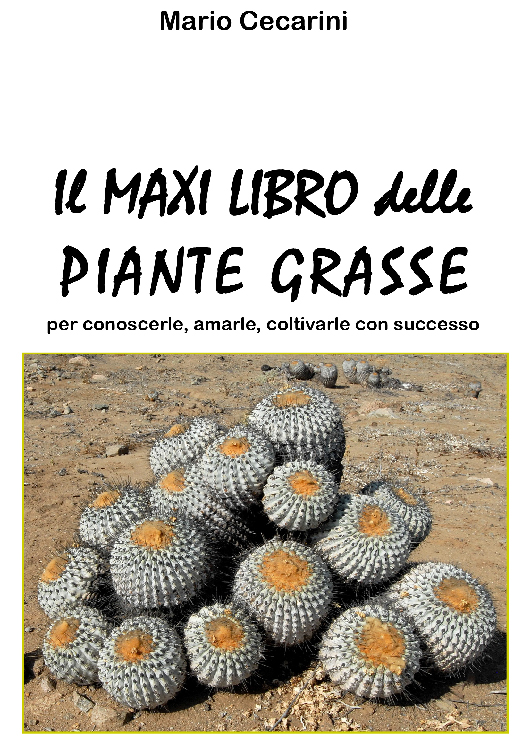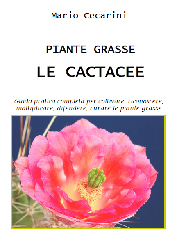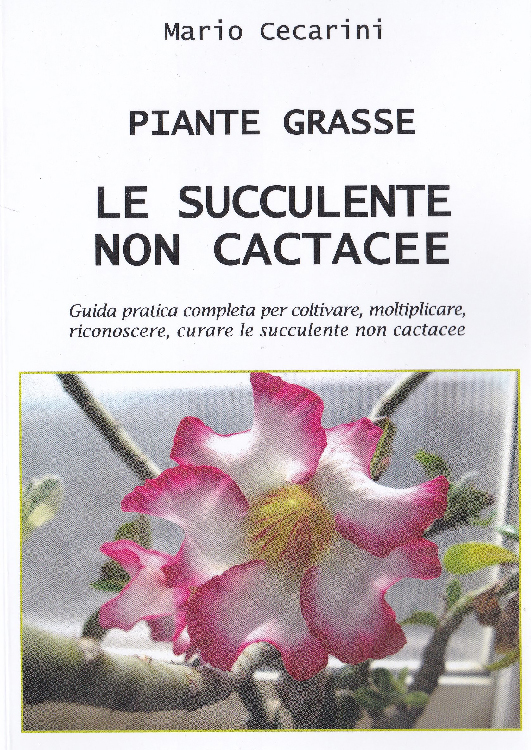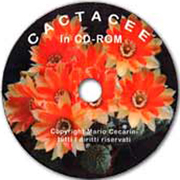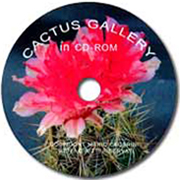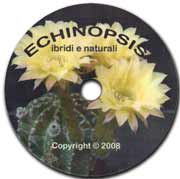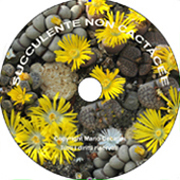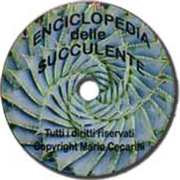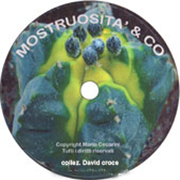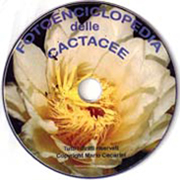QUESTIONS AND ANSWERS
Here beginners can find answers to their most frequently asked questions:
1 – Some of my succulents never set seed. Why is that so?
2 – How can I get my cacti to develop a thicker stem?
3 – How can I get in touch with other succulent enthusiasts living in my area?
4 – My Epiphyllum is now seven years old but has never flowered! Where do I go wrong?
5 – Suddenly my cactus has started rotting at the base. How can I save it?
6 – Should I always remove spent flowers?
7 – What is the difference between soil and sand in cultivation?
8 – Can I improve my soil adding beach sand?
9 – Do young seedlings need to be watered in the wintertime?
10 – I have bought a few pots of Lithops recently; how should I grow them?
11 – I have received a ‘wax plant’ as a gift; how do I take care of it?
12 – I bought my daughter, who is very fond of ‘caudiciforms’, a few specimens at a plant fair: one Adenium obesum, one Ficus petiolaris, one Fockea edulis and one Fouquieria splendens. What kind of cultural practices are suggested for such plants, especially in the wintertime?
13 – Which is the best period for repotting?
14 – When can I prick out my seedlings?
15 – I sowed some Lithops seeds about a month ago and then covered the tray with cling-film; now the young seedlings look mushy and seem to be rotting.
16 – I noticed that white fluffy patches have formed on some of my plants. Is that normal?
17 – While repotting one of my cacti I observed a whitish mass among the roots. What should I do?
18 – Some of my Mammillarias are in bloom although it is December now. Should I water them and in case repot them?
19 – I have got some early-blooming cacti which develop flower buds in February. Should I start watering my plants as soon as these appear?
20 – I live in a mountain town where the minimum winter temperature can go down to -12°C (10°F). I would love to grow some succulents which could be overwintered inside an unheated conservatory. Would they have any chance of surviving?
21 – I am new to the hobby and I have become enraptured by a certain group of succulents which goes under the name of ‘caudiciforms’. Should they all be treated the same way? And how?
22 – I have heard about hypocotyl grafting technique. How is that done?
23 – How do water, light and temperature during the wintertime affect flower formation in my cacti?
24 – My Euphorbia Obesa is in bloom; how can I tell if my plant is male or female?
25 – Last December I noticed the presence of black soft spots on two of my plants, Trichocereus Schickendantzi and Euphorbia Erithreae. The spots have now become larger and appear hardened. Are they at risk? How can I cure them?
26 – My town is located in the mountains and here the minimum temperature in the winter usually reaches -10°C (14°F); since I cannot build a greenhouse, which frost-tolerant succulent species can I grow? Would you be kind enough to make a list of all the fully hardy succulents?
27 – Last summer I bought quite a few cacti and now that winter is approaching I must figure out a way to protect them during the cold months. Someone told me that they should not be kept inside a heated place but rather in a frost-free, cool room which unfortunately I haven’t. The only option is to place them on a large southeast-facing balcony where the minimum temperature can easily be as low as -5/-6°C (23/21°F). How can I get my beloved plants to make it through the winter?
28 – I have a balcony where I set up a small lean-to greenhouse which unfortunately cannot be connected to the electrical system. How can I heat it during the winter?
29 – I have a few winter-growing succulents which I treat like indoor plants; however lately I have noticed that the apical growth is stunted and the plants look sickly and discoloured.
30 – My Euphorbia has reached almost one metre and a half (4.9 feet) in height but now a basal portion of its stem is dark-coloured and has a squashy appearance; should I worry about this?
1 – Some of my succulents never set seed. Why is that so?
– First we have to understand how fertilization occurs.
Some plants like those in the genera Frailea and Anacampseros are cleistogamous; that is to say that flowers usually remain unopened but the plant allows self-pollination and sets seed without the intervention of external agents.
Dioecious plants bear male and female flowers on separate individuals that is why a specimen is commonly referred to as either ‘male’ or ‘female’ (for example: Sedum rosea, Euphorbia obesa, Dioscorea etc.)
A third category is that of monoecious plants in which male and female flowers are borne on the same individual as is the case with some Cucurbits.
Lastly, the fourth and largest category, improperly defined as hermaphrodite, comprises almost all cactaceous plants. Their flowers have both stamens and carpels (the sporophylls) so they are easily fertilised. In the wild, however, self-pollination is generally avoided as it often results in genetic degeneration of the species while cross-pollination, which involves two different plants, is usually encouraged.
In many cacti, in fact, the stamens bear mature pollen as the flower discloses while the longer stigmas are still closed and unreceptive (protandrous flower). The stigma becomes receptive after the stamens have shed all their pollen so that it will be fertilised by pollen produced by another plant. Some other succulents like Weingarthia lanata produce stigmas which reach maturity before the pollen (protogynous flower).
Plants are therefore classified as either self-compatible or self-incompatible depending on whether they can be fertilised by their own pollen or not.
It would be best to cross-pollinate two plant individuals generated by different clones (which means not obtained from the same individual through any possible method of vegetative propagation). To pollinate our plants we must collect mature pollen from a flower using a small soft brush or simply cutting off the stamens with a pair of nail scissors. If the stigma is not yet receptive (once ready it appears open, glossy and sticky) we can store the pollen in a cool environment inside a plastic bag for three or four days; if you need a longer storage period you might try keeping it inside a freezer. After bringing the pollen back to room temperature proceed with the manual pollination by smearing some pollen onto the stigma making sure that the substance has a powdery texture and does not form lumps. To give it a better chance of success it would be ideal to repeat the operation at different hours during the day and if possible for more than one day since a favourable outcome is sometimes contingent on the temperature.
If the plant has protogynous flowers you will need to wait for the next bloom which means possibly a year.
A peculiar case is that of plants that use inhibitors to prevent self-pollination; if we want to obtain seeds from them despite their behaviour we can try deceiving them by performing a ‘false’ pollination with incompatible pollen and after a few hours, when the inhibitors will have been deactivated, fertilising the stigma using the flower’s own pollen.
Some plants, such as Haworthias, are difficult to pollinate because the stigma is situated deep in the calyx so the only way to deposit some pollen on it is using a long, slender brush. Asclepiadaceae and Apocinaceae also require specific methods of pollination.
If the stigma receives simultaneously its own pollen and that of another plant, the latter will prevail as it will be the first to reach and fertilise the egg cell.
2 – How can I get my cacti to develop a thicker stem?
– If your cacti have slender and weak stems this is probably the result of insufficient light especially if they look yellowish. To avoid this condition known as etiolation and to ensure your plants grow healthy provide plenty of light and air circulation.
3 – How can I get in touch with other succulent enthusiasts living in my area?
– You might try posting a message to one or more newsgroups about succulents otherwise joining a society or special interest group or simply participating in their web forums.
4 – My Epiphyllum is now seven years old but has never flowered! Where do I go wrong?
– To flower reliably Epiphyllums must be kept at a temperature of about 10°C (50°F) in the winter. During their period of rest, which generally begins in mid-November and ends in mid-February, keep the soil (2/3 loam, 1/3 perlite or pozzolan or sand) lightly moist but not soggy. As soon as the flower buds start to develop, water more abundantly adding a fertilizer with a low nitrogen content but rich in phosphorus, potassium and microelements. After flowering suspend watering and allow the plant to rest for three to four weeks in a shady place. During the warm months it is ideal to place the pot under the partial shade cast by a tree or alternatively choose a bright spot away from direct sunlight. Water regularly throughout the summer making sure that the soil dries out in between two waterings. Avoid using hard water; a few drops of lemon juice is useful in lowering the pH if necessary.
5 – Suddenly my cactus has started rotting at the base. What can I do to save it?
– If what you have noticed is actually rot and not just lignified tissue (which normally occurs in old specimens) I suggest you should cut the stem at the base and check its consistency. If it feels firm then your plant is fine; otherwise if it feels mushy you must remove the infected part using a sharp blade slicing the stem until the cut surface looks perfectly healthy and has no brown dots (disinfect the blade each time you make a cut in order to prevent the disease from spreading to the healthy tissues; to be extra careful remove some further centimeters above the last cut). Dust the wound with some fungicidal powder and allow the callous to form, placing the stem portion in a shady and ventilated spot. Root it as a cutting in a sandy mix, burying the stem not more than one centimetre in the soil and stake if necessary. Spray water on the plant and keep the soil slightly moist until roots have formed.
This operation has to be done promptly; in fact, if the disease is allowed to spread upwards to the apical region the plant will soon be dead.
6 – Should I always remove spent flowers?
– Of course, but do not pull hard if they don’t come off easily; simply wait a few more days. Avoid wetting dead blossoms as this might cause rotting. Water your plants from below instead.
7 – What is the difference between soil and sand in cultivation?
- Soil contains the nutrients that sustain plant growth whereas sand is merely a supporting medium therefore we need to mix them in the right proportions in order to obtain a fertile and well-drained substrate.
8 – Can I improve my soil adding beach sand?
- Absolutely not, if it has not been thoroughly washed beforehand to remove as much salt as possible. Generally river sand and builder’s sand are to be preferred especially if they are chalk-free. Quartz sand is probably the best. Sand particles must not be less than two millimetres in diameter.
9 – Do young seedlings need to be watered in the wintertime?
- Seedling are very delicate and if the stem diameter il less than two centimetres they should be lightly watered from time to time. The frequency depends on the temperature which must never be allowed to go too low. The soil should drain freely and dry out rather quickly.
10 – I have bought a few pots of Lithops recently; how should I grow them?
- Lithops belong to the Aizoaceae family; check the substrate in which they have been grown: if this is peat you should repot them in a suitable mix as soon as possible. Immerse the pots in a bucket full of water until the peat is thoroughly soaked; then extract the plants from their containers and place the rootball under running water until all the old soil is removed. Lastly, allow the roots to dry leaving the plants in a ventilated shady place for a few days; repot them in sandy soil (1 part of standard succulent compost plus 2 parts of sand - 2/4 mm in diameter). The operation should be done around April-May for all succulents, cacti included.
Watering should gradually start around April when the old leaves have almost completely dried up and go on until flower buds begin to develop, anyway not beyond the end of September/early October; leave the plants dry until the following April. In the summer months move the plants outdoors into full sun by degrees so as to avoid sunburn and possible death. During winter the minimum temperature recommended is around 4°C (39°F) although they might be able to withstand lower temperatures. They are susceptible to rot, mealy bugs and resent high winter humidity. They can be easily cross-pollinated a few days after the flower has opened.
11 – I have received a ‘wax plant’ as a gift; how do I take care of it?
- The botanical name of the plant’s genus is Hoya which belongs to the Asclepiadacee family. The natural habitat of these plant is the rainforest. A suitable soil for growing them is made up of 2 parts of leaf mould, 1 part of peat and 2 parts of coarse-grained sand (the size of rice). It thrives in dappled shade, plenty of air and high humidity. The minimum temperature should not go below 10°C/50°F (ideal 15-20°C/59-68°F) therefore they are often treated as indoor plants.
12 – I bought my daughter, who is very fond of ‘caudiciforms’, a few specimens at a plant fair: one Adenium obesum, one Ficus petiolaris, one Fockea edulis and one Fouquieria splendens. What kind of cultural practices are suggested for such plants, especially in the wintertime?
- The plants you have bought have a swollen stem base which acts as a storage organ (caudex); in cultivation this part of the stem is best kept above the ground: it may not grow as large as it could but this way we greatly reduce the risk of rot. Use a balanced succulent mix which ensures sharp drainage and position the pots in a well ventilated and bright place. During the winter rest keep the minimum temperature around 15°C (59°F) and sprinkle or spray a little water from time to time. Start watering as soon as the plants enter the vegetative phase and stop when they begin to shed their leaves.
13 – Which is the best period for repotting?
- Normally, the best moment for repotting is when plants start growing and for most plants this means spring. Repot with new, free-draining, dry soil. Wait a whole week before watering.
14 – When can I prick out my seedlings?
- Usually it is advisable to carry out this operation around Aprli or May of the year following sowing and never during the rest period. However, if the stem diameter of the seedlings is less than 15 mm you might as well wait another year. Delicate and very slow-growing genera such as Ariocarpus, Aztekium, Geohintonia, Blossfeldia, Islaya etc. resent being transplanted so it is recommendable to wait at least 3 or 4 years before doing it.
15 – I sowed some Lithops seeds about a month ago and then covered the tray with cling-film; now the young seedlings look mushy and seem to be rotting.
- I am afraid there is nothing you can do now. You should have removed the film immediately after germination and let the air circulate to reduce humidity; spraying the seedlings with a good fungicide would have also helped.
16 – I noticed that white fluffy patches have formed on some of my plants. Is that normal?
- No, you must eliminate them straightaway since those are mealy bugs which feed on the plant sap inhibiting growth and eventually causing death. Remove by hand or use a specific product against scale insects (Fenix for example).
17 – While repotting one of my cacti I observed a whitish mass among the roots. What should I do?
- What you have noticed are most likely root mealy bugs even more dangerous than those which attack the stem as they are more difficult to spot: stunted or no growth at all may be a symptom of their presence. Once the diagnosis is confirmed you must take action immediately: remove the soil washing the roots under a jet of water then leave the root system to soak for a few minutes in a solution of water and a specific anticoccidial. After this let the roots dry and repot in good sterilised soil; wait a whole week before watering. These operations must be carried out during the growing period so it is important to make sure that there are no such pests in the wintertime and to do so you need to treat for root mealy bugs preventively in the spring and also in the autumn with the last watering of the season.
18 – Some of my Mammillarias are in bloom although it is December now. Should I water them and in case repot them?
- You shouldn’t do either. This is the time when cacti must be kept dry even if in bloom or else they are likely to rot. Watering should start again around March or when the mean night temperature is about (stabilised?) 8°C (46°F). Wait until spring also to repot.
19 – I have got some early-blooming cacti which develop flower buds in February. Should I start watering my plants as soon as these appear?
– No; you need to wait until spring anyhow, when the mean night temperature is about 8°C (46°F).
20 – I live in a mountain town where the minimum winter temperature can go down to -12°C (10°F). I would love to grow some succulents which could be overwintered inside an unheated conservatory. Would they have any chance of surviving?
- Of course, as long as you choose the right genera and species. Plants like Pediocactus, Toumeya, Uthaya, Escobaria, Austrocactus, Neowedermannia but also many Opuntias, Tephrocactus, Mahuenia, Sophora are cold-hardy and almost every species within these genera is stimulated to flower profusely in the spring by low winter temperatures.
It is quite a long list for we might also include Acanthocalycium klimpelianum, A. peithscherianum, A. violaceum; Agave Ferdinandi regis, A. filifera, A. lechuguilla, A. mackelveyana, A. neomexicana, A. palmeri, A. parviflora, A. schottii, A. toumeyana; Aloinopsis malherbei, A. rubrolineata; Ancistrocactus tobuschii, A. uncinatus; Aporocactus flagelliformis; Cephalocereus senilis; Cereus peruvianus; Cleistocactus strausii; Echeveria strictiflora; Echinocactus horizontalonius, Echinocereus dasyacanthus, E. delaetii, E. fitchii, E. gentryi and many more..
The following list comprises plants that can easily tolerate temperatures as low as -20°C (-4°F):
Agave utahensis, A. havardiana; Aloinopsis peersii, A. rosulata; A. schoonesii, A. spathulata; Dasylirion texanum; Delosperma anulare, D. cooperi, D. nubigenum; Dolichothele longimamma; Echinocactus glaucus, Echinocereus caespitosus, E. coccineus, E. engelmannii var. chrysocentrus and variegatus, E. viridiflorus; Echinopsis sylvestri; Micropuntia pigmaea; etc.
Cultivation tips: ensure good air circulation all year round and make sure they stay dry during the winter by providing shelter from precipitation; in the spring they enjoy cool temperatures and being kept fairly moist. Water deeply every once in a while in the summer months leaving them dry most of the time. In the autumn they favour cool temperatures with some occasional light watering. Some species need grafting to be grown successfully.
21 – I am new to the hobby and I have become enraptured by a certain group of succulents which goes under the name of ‘caudiciforms’. Should they all be treated the same way? And how?
- Caudiciforms, together with pachycauls, are plants which develop a swollen basal stem and are found within some forty plant families. Some are cold-hardy, others are vigorous and can even tolerate some neglect, still others require constant care and warm temperatures also when dormant.
Genera like Kedrostis, Cyphostemma, Pelargonium, Nolina, Pachypodium (lamerei, geayi and saundersii), Dioscorea, Fouquieria, Cotyledon (dwarf species) are suitable for the beginner. They need well-drained soil (any good succulent mix will do), plenty of air, partial shade and minimum temperatures of about 5°C (41°F) during the rest period and regular watering when in active growth (let the soil dry out in between). As for most succulents start watering at the first signs of awakening and stop when leaves are shed; do not water if in doubt and do not use hard water.
22 – I have heard about hypocotyl grafting technique. How is that done?
- The hypocotyl region is located between the root and the cotyledon of a newly born plant. This technique consists in removing, only a couple of months after germination, the roots of the seedling we intend to graft onto a more robust stock, opportunely sown a few months before the scion. The most suitable rootstocks to be raised from seed are Pereskiopsis velutina, spathulata, porteri; less so are Cereus peruvianus and jamacaru. It is also possible to use small offsets from young plants of Selenicereus.
This is just an alternative method to the standard graft usually done on Pereskiopsis; the only difference is using a 4 or 5-month-old seedling instead of grafting on top of cuttings.
Here is how you do it:
- Perform the operation on a windless day from early May into mid-August.
- Use a sharp razor blade, cleaned and disinfected.
- Cut off the roots from the scion and the cotyledons from the stock (Pereskiopsis) in the hypocotyl region (just below the cotyledons).
- Quickly place the scion onto the rootstock pressing gently with your fingertips. Care must be taken to ensure that the vascular rings of both scion and stock match or at least cross and this can be achieved by slightly offsetting the scion towards the edge of the larger cut surface of the stock.
- It is recommendable, though not essential, to place a sort of hard plastic cover weighing a few grams, better if transparent, over the scion for a couple of days so as to maintain a certain pressure and allow the vascular bundles to make contact.
- If the scion has not dried up by the next day the graft has taken.
- Position the grafted plant in bright indirect light at 25°C (77°F) or so.
- You need a little experience to do it correctly and smoothly.
This method is suggested for plants with a tap-root system; alternatively use Pereskiopsis cuttings about ten centimetres long, removing the extremity where the section is 3 to 5 mm in diameter. The stock does not need to be rooted yet as it can easily develop roots afterwards.
23 – How do water, light and temperature affect flower formation in my cacti during the winter?
- In the wintertime cacti prefer, with few exceptions, a minimum temperature of about 6°C (43°F), a dry environment and high light levels (though this last condition is not always essential). If the temperature rises and stays around 18°-20°C (64-68°F) for a while then we should water with the risk of inducing the plants to break dormancy and, in all likelihood, miss the next flowering season.
24 – My Euphorbia Obesa is in bloom; how can I tell if my plant is male or female?
- If its flower has stamens which consist of a filament and an anther containing the pollen and lasts only one day then it is a male specimen; on the contrary if the flower has a pistil bearing a stigma with three bifid lobes and lasts for several days, your plant is female.
25 – Last December I noticed the presence of black soft spots on two of my plants, Trichocereus Schickendantzi and Euphorbia Erithreae. The spots have now become larger and appear hardened. Are they at risk? How can I cure them?
- Formulating a diagnosis without being able to examine the plants is always very difficult. On first approximation I would say they are suffering from a fungal disease, apparently not so aggressive, which should not pose a threat to the life of your plants. For the moment I advise that you treat the diseased plants with copper oxychloride to be applied as a solution or powder. In the spring, when plants start to grow again, drench the soil with a solution of water and a systemic fungicide such as Aliette, Previcur or any other Propamocarb-based product.
Here follows some more advice given as additional information about the subject. If, unfortunately, the disease progresses it may be necessary to remove the affected portion of stem by slicing it until the exposed surface looks perfectly healthy, with no dark dots (do not forget to sterilise the blade with spirit each time you make a cut). It is fundamental to determine whether the infection originates from the upper or the lower part of the stem. At the end of the operation dust the surface with a mixture of 2 parts of copper-sulphur powder and one part of carbon powder. If you have removed the apex the plant will produce new shoots; on the other hand if the discarded part is the lower stem, treat the healthy portion as a cutting.
If the fungal disease has spread throughout the plant via the vascular system or in the case of a viral infection, there is no possible remedy and the plant will surely die. So the only way to control effectively this kind of diseases is mainly prevention: a treatment in the spring and autumn with specific products having both protectant and systemic action.
26 – My town is located in the mountains and here the minimum temperature in the winter usually reaches -10°C (14°F); since I cannot build a greenhouse, which frost-tolerant succulent species can I grow? Would you be kind enough to make a list of all the fully hardy succulents?
- You can grow a great variety of succulents that you will find listed below in alphabetical order. These plants can tolerate low temperatures provided that they are sheltered from winter wet and the roots stay dry. See also answer to question n. 20 in regard to cultivation.
Acanthocalycium klimpelianum, A. peitscherianum, A. violaceum; Agave Ferdinandi regis, A. filifera, A. franzosinii, A. havardiana, A. lechuguilla, A. mckelveyana, A. mexicana, A. palmeri, A. parviflora, A. schottii, A. toumeyana, A. utahensis; Carnegiea gigantea; Cephalocereus senilis; Cereus peruvianus; Chamaecereus silvestrii; Cleistocactus areolatus, C. strausii; Conophytum minutum;Coryphantha compacta; C. echinus, C.f ragrans, C. gladiispina, C. lauii, C. obscura, C. ramillosa, C. runyonii, C. scheerii, C. sulcata; Cylindropuntia clavata; Dasylirion texanum, D. wheeleri; Delosperma anulare, D. cooperi, D. echinatum, D. nubigenum; Denmoza rhodacantha; Dolichothele longimamma; Echeveria strictiflora; Echinocactus glaucus, E. grusonii, E. horizonthalonius, E. ingens, E. polycephalus, E. xeranthemoides; Echinocereus adustus, E. berlandieri, E. blanckii, E. bristolii, E. caespitosus, E. chloranthus, E. coccineus, E. dasyacanthus, E. delaetii, E. ehrembergii, E. engelmannii, E. fendleri, E. fitchii, E. gentryi, E. knippelianus, E. lauii, E. ledingii, E. leonensis, E. lloydii, E. longisetus, E. melanocentrus, E. mojavensis, E. palmeri, E. paucispinus, E. pectinatus, E. polyacanthus, E. poselgeri, E. reichenbachii, E. rigidissimus, E. scheeri, E. schmollii, E. stramineus, E. triglochidiatus, E. viridiflorus; Echinomastus dasyacanthus, E. johnsonii, E. mariposensis; Echinopsis ancistrophora, E. calochlora, E. eyriesii, E. oxygona, E. ritteri, E. shaferi, E. silvestri, E. turbinata, E. valida, E. violacea; Epithelantha micromeris; Escobaria chaffeyi, E. dasyacantha, E. duncanii, E. guadalupensis, E. esteri, E. laredoi, E. leei, E. missouriensis, E. orcuttii. E. organensis, E. roseana, E. sandbergii, E. sneedii, E. tuberculosa, E. variicolor, E. vivipara; Espostoa lanata; Euphorbia bergeriana; Ferocactus acanthodes, F. emoryi, F. hystrix, F. johnsonii, F. wislizeni; Glottiphyllum linguiforme; Gymnocalycium brachypetalum, G. bruchii, G. calochlorum, G. damsii, G. gibbosum, G. mazanense, G. saglionis, G. schatzlianum, G. schickendantzii, G. spegazzinii, G. tilcarense; Hamatocactus hamatacanthus, H. setispinus; Harrisia jusbertii, H. martinii, H. tortuosa; Haworthia atrovirens, H. fasciata; Hesperaloe parviflora; Hibervillea tenuisecta; Lemaireocereus dumortieri, L. thurberi; Lobivia aurea, L. bruchii, L. famatimensis, L. ferox, L. haematantha, L. maximilliana, L.pentandli, L.williamsii; Machaerocereus eruca; Maihuenia poeppigii, M. tehuelches; Mamillopsis senilis; Mammillaria barbata, M. bocasana, M. elegans, M. elongata, M. erythrosperma, M. gracilis, M. grahamii, M. hahnii, M. kunzeana, M. longiflora, M. meiacantha, M. prolifera, M. santaclarensis, M. tetracantha, M. vetula, M. viridiflora, M. wrightii; Micropuntia pygmaea; Navajoa fickeisenii; Neobesseya missouriensis; Neolloidia conoidea; Neoporteria umadeave; Nolina bigelowii, N. recurvata; Nopalea cochenillifera, N. guatemalensis; Notocactus allosiphon, N. concinnus, N. mammulosus, N. ottonis, N. scopa, N. submammulosus; Opuntia compressa, O. fragilis, O. humifusa, O. macrorhiza, O. scheeri, O. strobiliformis; Oreocereus doelzianus, O. hendriksenianus, O. trollii; Oroya neoperuviana, O. peruviana; Oscularia deltoides; Othonna crassifolia; Pachycereus pringlei; Pachyphytum bracteosum; Parodia aureispina, P. microsperma; Pediocactus (all species); Pyrrhocactus bulbocalyx; Rebutia deminuta, R. fiebrigii, R. kupperiana, R. minuscula, R. pseudodeminuta, R. senilis, R. kirilowii, R. perfoliata; Sedum (almost all species); Stapelia variegata; Thelocactus bicolor; Toumeya papyracantha; Trichocereus (almost all species), Trichodiadema densum; Wilcoxia poselgeri, W. schmollii, W. tuberosa, W. viperina.
27 – Last summer I bought quite a few cacti and now that winter is approaching I must figure out a way to protect them during the cold months. Someone told me that they should not be kept inside a heated place but rather in a frost-free, cool room which unfortunately I haven’t. The only option is to place them on a large southeast-facing balcony where the minimum temperature can easily be as low as -5/-6°C (23/21°F). How can I get my beloved plants to make it through the winter?
- A possible solution could be buying a small lean-to greenhouse or a metal potting bench kit usually available in stores. While the greenhouse is already provided with a covering you will need to screen every side of the structure with plastic sheet securing it with the appropriate fastenings except one of the lateral sides that you will cover with horticultural fleece to ensure good ventilation. It is advisable to close the front side with a wooden frame which encloses the plastic sheet and functions as a door; secure it with rubber bands so that it can be easily removed.
A few light bulbs, possibly controlled by a timer, will provide some heating; a series of tests with a min/max thermometer placed inside the conservatory will determine how much power is needed. Alternatively you can use a hairdryer. A much more practical solution is installing a small electric fan heater with full thermostat control and an auto frost stat setting that is activated when the temperature falls below 5°C (41°F). During warm sunny spells make sure the inside temperature never exceeds 40°C (104 °F) opening the door if necessary. Full sun exposure in the winter months is beneficial and stimulates more abundant flowering.
28 – I have a balcony where I set up a small lean-to greenhouse which unfortunately cannot be connected to the electrical system. How can I heat it during the winter?
- If you need to raise the temperature by only a few degrees you can utilize a camp cooker operating on a butane-propane cartridge. Should this not be enough, use a small gas heater fuelled by a liquid propane cylinder.
29 – I have a few winter-growing succulents which I treat like indoor plants; however lately I have noticed that the apical growth is stunted and the plants look sickly and discoloured.
- This is due to lack of light. You need to provide artificial lighting using lamps whose spectrum is similar to that of natural light. Such lamps can be found in aquarium stores. Unfortunately malformations caused by inadequate lighting are permanent.
30 – My Euphorbia has reached almost one metre and a half (4.9 feet) in height but now a basal portion of its stem is dark-coloured and has a squashy appearance; should I worry about this?
- The brownish appearance of the stem base in adult plants is quite normal; what is alarming is the fact that it also looks squashy. I am afraid your plant has been hit by a fungus that attacked the root system and is now spreading upwards. You can perform some sort of biopsy to evaluate the progression of the disease. If it has already reached the core of the stem your are left with one last option, however unpleasant it may sound: pruning the stem and rooting the healthy part as a big cutting. Make a straight cut across the stem and if the exposed area doesn’t look healthy repeat the operation moving further away from the affected part until the cut surface shows no trace of darker spots and looks unblemished. Remember to disinfect the blade after each cut. To stop the sap dripping from the wound immerse the cutting in hot water (60°C – 140°F approximately) for one minute then dust the surface with sulphur-copper powder. Leave the cutting in a shady, warm place for a fortnight or so until the wound has calloused. After that, insert the cutting in a rooting medium such as sand tying it to a support if necessary; keep the substrate slightly moist until new roots have formed.
If the bottom of the stem rots instead of forming a callus you may not have removed enough of the diseased part or disinfected the tools properly, therefore you will have to repeat the whole process although the chances of success will be lower this time.



 F.A.Q.
F.A.Q.



